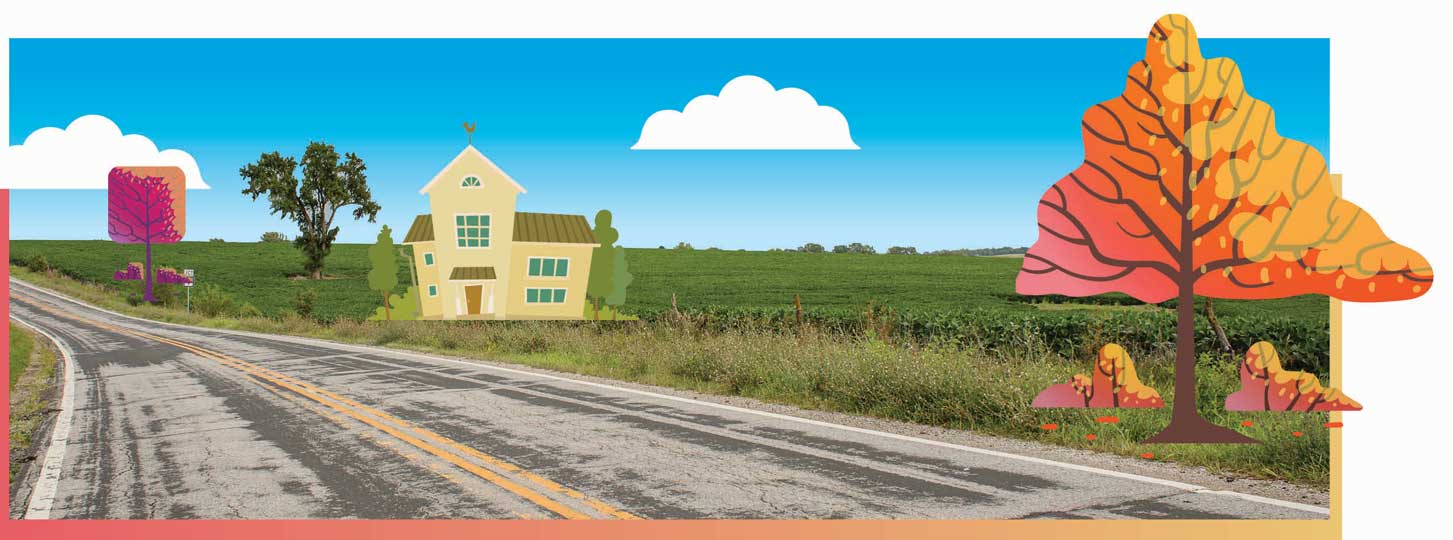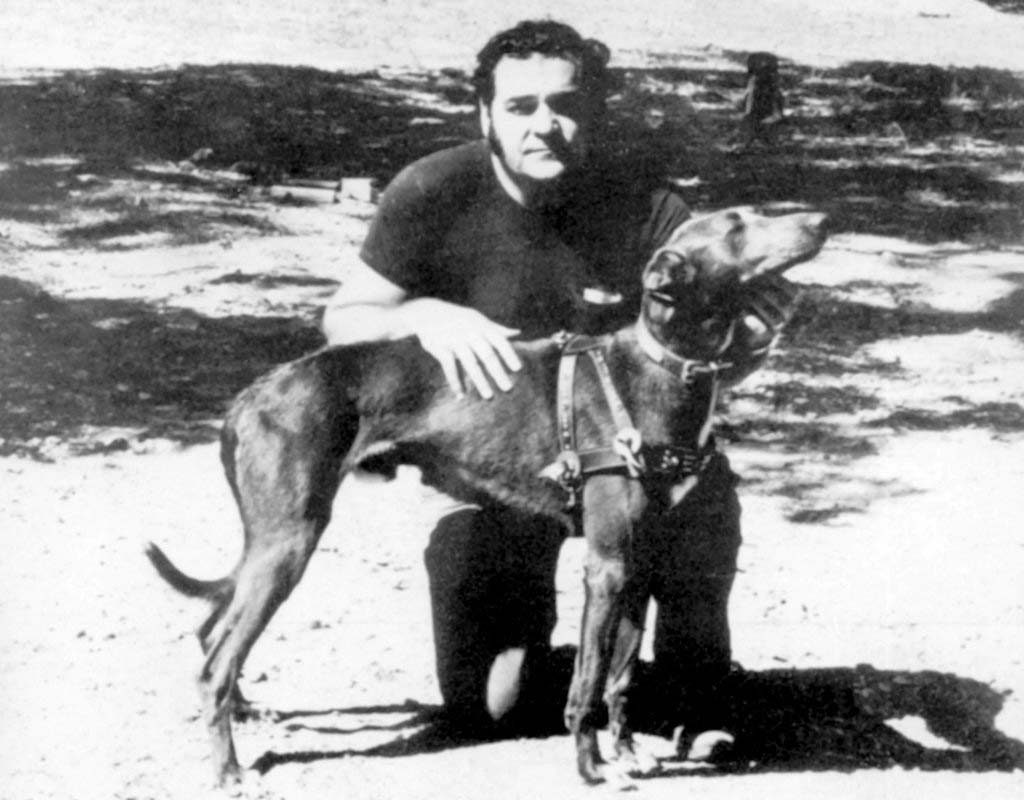Of the town’s dark past, the current mayor, Tracy Shewey, sees the notoriously awful events as small, isolated incidents, dismissing them as “weird things” that she’s never bothered to explicitly explain to her children. She assumes it’s like that for most Skidmore parents.
“Just because those bad things happened doesn’t mean the whole town and the whole community is bad,” Tracy says. “For newcomers, it does come up. And what we say is, ‘That’s not all that we’re about. We’ve had a couple of things that have been not so pleasant, but to us that doesn’t define the town. Please see past that. If you can’t, you’ve got to move on.’ ”
When Sandy stepped down as mayor in 2016, Tracy seamlessly carried the momentum forward. As a lifelong resident of Skidmore, she knows most of its families, streets, and even the rooms of many of its houses. Tracy’s family has been in the Skidmore area for generations; she married a local man named Kenny, had a family, and raised her children here. Armed with memories of her own upbringing and family life, she considers it a near-perfect place to raise kids, and she wants to market its smalltown appeal for other working families.
“I know there’s not a lot to offer, but with our projects, people might think it’s not such a bad place to live,” she says.
With Sandy invested in downtown real estate, Tracy is redirecting city hall’s attention to building a stronger sense of community. When someone new moves to town, she volunteers her husband to carry boxes out of moving trucks. When her son flipped his car last July, neighbors brought cookies.
Tracy and other residents would like to find a way to make that Skidmore goodwill more visible to newcomers. The methods don’t have to be elaborate. One idea Tim plans to propose to the city council is a Yard of the Month prize. Annie’s garden, with its irises and roses, happens to be one of the most beautiful in town.
“Okay, so you get a cheesy sign stuck in your yard that says Yard of the Month. But you know what? I want one,” he admits. “I would hope that out-oftowners see a nice, well-kept community. Compared to what it was a couple years ago, it’s a lot better. We’re getting there. We’ve lived in other towns that have accepted everybody moving away, and they don’t do anything about it. If Skidmore completely dies out, it’s not going to be from lack of trying.”
One form of soft protest against continued decline is the community’s hope that the post office will remain open. Although the city received a new post office in 2010, the widespread shutdown of rural post offices that began in 2011 has kept locals on high alert.
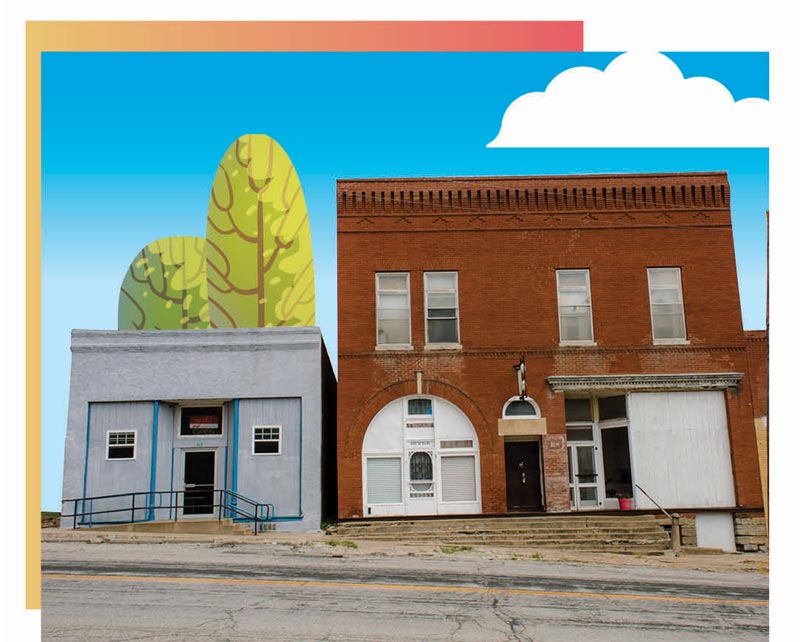
with good potential for investors.
To invested residents like Kenny Shewey, Tracy’s husband, such an event would be devastating. Like many locals, he wears several hats—serving triple duty as the town’s commercial vehicle enforcement officer, volunteer fire department member, and vice president of Skidmore Community Betterment. He’s watched for years as communities in a constellation surrounding Skidmore have shrunk. He looks at the nearly extinguished community of nearby Quitman, which lost its post office several years ago. From the state’s perspective and that of any nonlocal, Quitman is gone. These days, Quitman residents receive mail through the Skidmore district. To Kenny, maintaining the post office is vital to the town’s preservation. After all, he says, “It’s our name.”
Before media impressions were hijacked by the Ken McElroy killing, Skidmore had gained some notoriety as the home base of a band called Festival Family. Aghast by the public’s treatment of returning Vietnam War servicemen, a Skidmore resident and veteran named Britt Small organized the musical group in 1973. The 12-piece show band performed patriotic music to express appreciation for veterans. For the next 28 years, the band traveled more than 2.5 million miles to perform. Among the most notable venues were Mount Rushmore, the Lincoln Memorial in Washington, DC, and at the Vietnam Veterans Memorial. Festival Family was the only band to ever perform at that site in the nation’s capital. And every year, the band returned to Skidmore to play at an annual event called Freedom Festival.
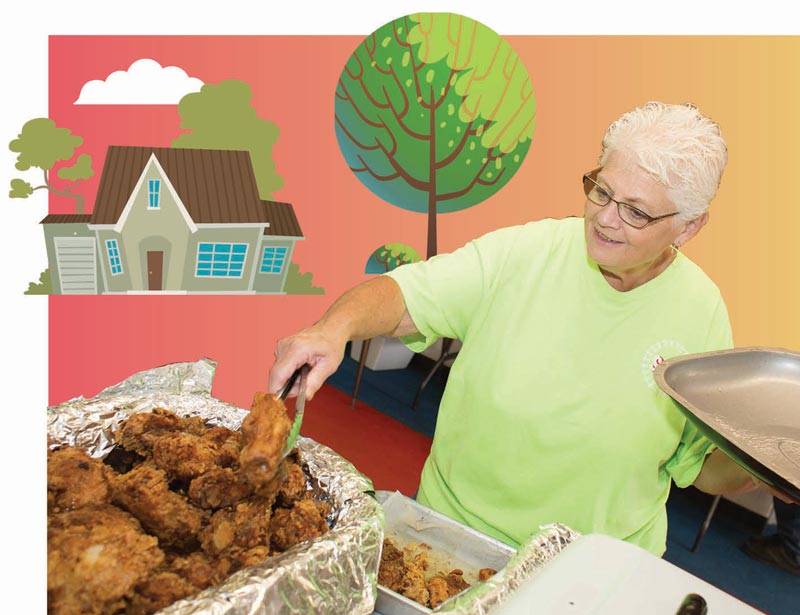
“Freedom Fest was the best thing to ever happen to this town,” says Jim Blessington, blinking back tears.
Freedom Fest emerged from Festival Family in 1987 as a patriotic tribute for veterans every September. The band stopped performing in 2001, and without it, the beloved Freedom Fest sees little chance of revival. But music hasn’t left the town completely. Next door to Good Time Charlie’s is the Max Stout (pronounced “Maxxed Out”) recording studio, which draws dozens of regional artists and bands a year, including the St. Joseph Symphony and bluesman Jerry Forney. “Max Stout is here because [Festival Family] ended up here,” says owner Mark Reinig, who was the assistant band leader, drummer, French hornist, and one of the lead singers of Festival Family for 28 years. “It is the best recording studio in town. And if you want qualifiers, I am the world’s best Skidmore recording studio.”
With Good Time Charlie’s located next-door to the studio, the restaurant is an ideal spot for traveling artists to patronize. Sandy also plans to host live music occasionally, which is a nice nod toward the town’s musical past. There seems to be a renewed desire to continue efforts to foster community pride.
“I didn’t grow up here, but I think a lot of people are remembering, ‘Oh, when I was young, we had the Punkin Show and parades, this and that.’ And they want that for their kids,” says Rana Killingsworth, who moved to Skidmore in 1995.
Although many residents speak wistfully of past Punkin Shows, there doesn’t seem to be quite enough of a push to fully revive it as it was in the old days. Back then, Skidmore’s farmers were producing diverse crops, and the surplus kept the town fed and money within the community. According to the Centennial History Book by Skidmore Community Betterment, local business leaders wanted to “show their appreciation by making things pleasant for the farmer,” and founded an annual celebration to honor the farming community. That first year, the prize-winning pumpkin was awarded $5 in cash—a hefty sum for 1899.
But where there once were apple orchards and cabbage fields, the area that surrounds Skidmore today is an endless patchwork of corn, soybeans, and the occasional cattle farm. The Punkin Show was called off in 2004.
To recapture the spirit of the Punkin Show and Freedom Festival, Sandy began promoting Skidmore Community Day in 2015. The event features a flea market, live music, a horseshoe competition, and barbecue. In 2016, organizers added a bike and car show, horseshoe pitching, and a softball tournament. There’s also the annual Mud Run. This year, it attracted several hundred people and 30 trucks, and it will likely become an annual community staple.
Sandy Wright sees these events as potential drivers for economic growth. If Skidmore is capable of drawing crowds, there’s an opportunity to be seized. “Now we just have to have a reason for them to stay,” she says.
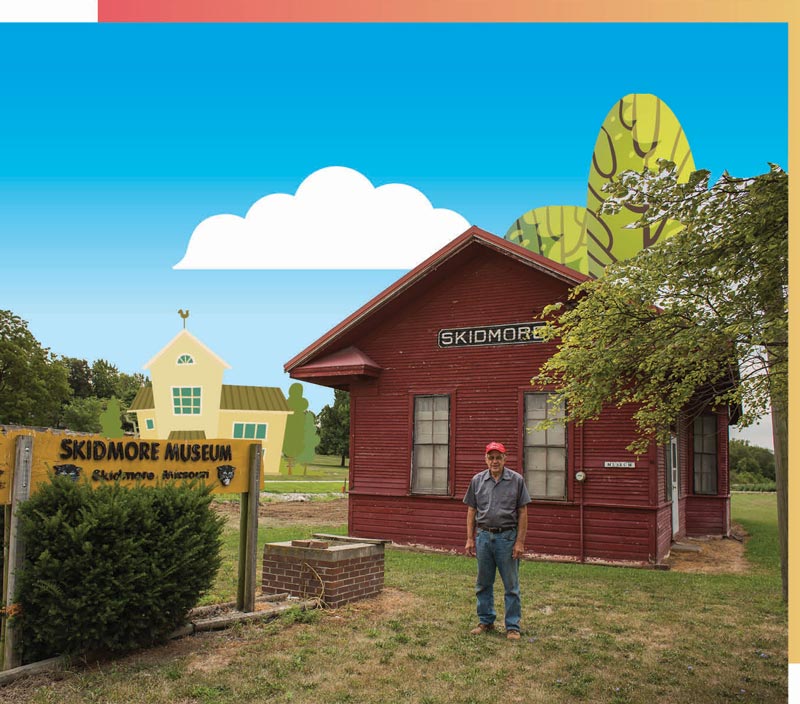
In recent years, the city council has worked tirelessly to pass ordinances requiring people to keep tidier yards; those efforts have improved first impressions of the town. But the tax base in Skidmore is still tiny, and there are more practical problems to attend to, such as updating the city sewage system. While Sandy works on finding ways to attract and encourage new business, Skidmore Community Betterment focuses on making the town a nice place to live. The major projects on the agenda right now are building a new basketball court and walking trails. Funds for these recreational sites and general city park improvements largely come from community efforts with the Skidmore Community Betterment group.
“We have a handful of people in town who like to take walks, and it’d be nice for them to have a place. It matters,” Tracy says. “It’s important to give people something about their little town that they can use and be proud of.”
The estimated cost for these two projects hovers around $50,000, though there is talk of asking for new estimates. So far, Skidmore Community Betterment has raised roughly $9,000. Eventually, the group plans to apply for a matching grant, but that won’t happen until the local funds reach perhaps $25,000. Doubling it would easily cover the costs. But these things take time.
“Hopefully, little by little, we can help where we can,” Tracy says. “Maybe we can at least hold steady to what we have. Maybe we can gain a little bit. I’m hopeful. I can’t see how it hurts anything, that’s for sure. We’ve got to do something. We don’t want to waste away and be nothing.”
In the 1800s, Newton Hall was a hotel and cafe, so it seems fitting that it serves as today’s hub for community betterment dinners in Skidmore. During the week, the building serves as the town library, as evidenced by the haphazard bookshelves that line the blue wallpapered walls. But today, it has been transformed for the fried chicken dinner the betterment group holds a few times a year to help raise money for the basketball court and walking path projects. The mood is bright; the goal is to raise $500.
Silver buffet trays and receptacles line a long table. Some are already filled with gleaming slices of ham, another boasts country-stewed green beans and bacon. Lindy and Jim Blessington toss their kitchen sink salad right in the pan. In the kitchen, Terry Diggs is frying chicken. Kenny Shewey mashes the potatoes. The dessert table glistens with donated sweets—banana bread, German chocolate cake, butterscotch pie, lemon pudding cake, a local curiosity called grape pie, and more. Jane Martin, 90, is cutting towering slices of her famous fruit cocktail cake. Nearby, the betterment group’s youngest member, 19-year-old Brandon Adkins, rolls napkins around silverware.
“We’re going to tie him to a tree just to keep him here,” Jane jokes. “Who else is going to do these things once we’re gone?”
Brandon just laughs shyly.
Around 11 am, people begin trickling in, dropping small bills into a large glass jar as Tracy writes down their names to track attendance. A young woman visits with people at various tables, sharing photos of her wedding dress. Bruce Roberts shows up in his Sunday best, eats a meal sitting at the table, and then takes a to-go box for his wife, Anna, who couldn’t make it but didn’t want to miss the food.

“It’s fun to sit back and watch people,” Kenny says. “Families of four or five people will come in and eat, but they’re coming to visit. People come here for fellowship.”
For the next few hours, the dining room is noisy with chatter. The meal stretches into early afternoon. There are no formal speeches or petitions about the importance of community or raising funds. When Kenny tries to hold a banner against the window, it keeps rolling back across his hands, sparking a flood of laughter and friendly jabs from the diners. The atmosphere in the room evokes all the familiar banter of a family dinner table, of people who love each other enough to move past chiding without apology. The pie is eaten, the chicken gets cold, and the remaining leftovers are boxed up to be taken to shut-ins.
A few days later, Rana tallies up the funds raised from the dinner: $443.40.
It’s not much.
But it’s something
Related Posts
Skidmore Revisited Part 2: Weary Memories
The town became nationally known for the murder of a bully. But the people who call it home know what it's really like.
Skidmore Revisited Part 1: The Death of Ken McElroy
Ken had a drink at the bar, left, started his truck, and lit a cigarette. And then someone shot him in the head, in broad daylight, before 45 witnesses, with Trena at his side. After decades of terror, the bully was finally gone.
Earthly Creations
They say that life is what happens while you’re busy making plans. We’re pretty sure you’d get no argument from Sandra Zak.

